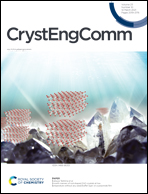Growth and characterization of diamond single crystals grown in the Fe–S–C system by the temperature gradient method
Abstract
FeS is the main sulfur-containing compound encased in natural diamonds, and the study of FeS-doped diamond crystal properties in the Fe–S–C system is highly significant for the exploration of the origins of natural sulfur-containing diamonds. In this work, the characteristics of FeS-doped diamond crystals are studied using a large-volume cubic high-pressure apparatus with pure iron as the medium at 6.0 GPa and 1400–1450 °C. The crystals were characterized by optical microscopy (OM), scanning electron microscopy (SEM), X-ray photoelectron spectroscopy (XPS), Fourier transform infrared spectroscopy (FTIR) and Raman spectroscopy. The OM results show that with increasing doping ratio, cracks appear in the crystal, and the growth rate of the diamond first increases and then decreases. The FTIR spectra show that with increasing doping ratio, the N content of the crystals also shows a trend of first increasing and then decreasing. Raman spectroscopy analysis shows that FeS-doped diamond crystals have a high-quality sp3 structure, and as the doping ratio increases, the Raman peak full width at half maximum values of the crystal first decrease and then increase. The XPS spectra of the crystal indicate that the sulfur in the Fe–S–C system successfully entered the diamond lattice grid through the formation of C–S–O, C–S–SO2–C and C–O–S bonds.

- This article is part of the themed collection: Crystal Growth


 Please wait while we load your content...
Please wait while we load your content...